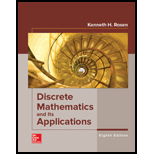
Concept explainers
etimes we cannot use mathematical induction to prove a result we believe to be true, but we can use mathematical induction to prove a stronger result. Because the inductive hypothesis of the stronger result provides more to work with, this process is calledinductive loading.We use inductive loading in Exercise 74-76.76.Suppose that we want to prove that
for all positiveintegers n.
- Show that if we try to prove this inequality using mathematical induction, the basis step works, but the inductive step fails.
for all integersrgreater than 1, which, together with a verification for the case wherer= 1, establishes the weaker inequality we originally tried to prove using mathematical induction.
Want to see the full answer?
Check out a sample textbook solution
Chapter 5 Solutions
Discrete Mathematics and Its Applications ( 8th International Edition ) ISBN:9781260091991
Additional Math Textbook Solutions
Elementary & Intermediate Algebra
Pathways To Math Literacy (looseleaf)
Precalculus
Precalculus: Mathematics for Calculus (Standalone Book)
Finite Mathematics for Business, Economics, Life Sciences and Social Sciences
Probability And Statistical Inference (10th Edition)
- Algebra & Trigonometry with Analytic GeometryAlgebraISBN:9781133382119Author:SwokowskiPublisher:Cengage
 Linear Algebra: A Modern IntroductionAlgebraISBN:9781285463247Author:David PoolePublisher:Cengage Learning
Linear Algebra: A Modern IntroductionAlgebraISBN:9781285463247Author:David PoolePublisher:Cengage Learning College Algebra (MindTap Course List)AlgebraISBN:9781305652231Author:R. David Gustafson, Jeff HughesPublisher:Cengage Learning
College Algebra (MindTap Course List)AlgebraISBN:9781305652231Author:R. David Gustafson, Jeff HughesPublisher:Cengage Learning  Algebra and Trigonometry (MindTap Course List)AlgebraISBN:9781305071742Author:James Stewart, Lothar Redlin, Saleem WatsonPublisher:Cengage Learning
Algebra and Trigonometry (MindTap Course List)AlgebraISBN:9781305071742Author:James Stewart, Lothar Redlin, Saleem WatsonPublisher:Cengage Learning
 College AlgebraAlgebraISBN:9781305115545Author:James Stewart, Lothar Redlin, Saleem WatsonPublisher:Cengage Learning
College AlgebraAlgebraISBN:9781305115545Author:James Stewart, Lothar Redlin, Saleem WatsonPublisher:Cengage Learning





